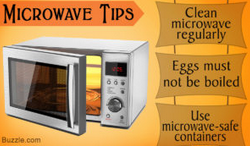Tips for cooking in a microwave oven — bet you didn’t know some of them!
By Jill Nystul
There’s no denying that the microwave can be a useful and highly convenient appliance. But there’s also a lot that can go wrong when you’re using an appliance that is producing powerful radiation! Just ask my youngest son Sten, who as a young child tried to microwave Cup Noodles without any water inside. It produced an impressive amount of smoke, and the smell of burning noodles lingered in our kitchen for several days. (No real harm was done though, so we still get a good laugh out of that memory!)
without any water inside. It produced an impressive amount of smoke, and the smell of burning noodles lingered in our kitchen for several days. (No real harm was done though, so we still get a good laugh out of that memory!)
But many microwave mishaps aren’t quite as harmless as Sten’s was. Potential outcomes include explosions, leaching chemicals, and unsafe food, to name just a few! But the good news is that all of these outcomes are entirely avoidable! Today I’ll be sharing 15 different behaviors to avoid when it comes to using your microwave. I’ll tell you why each behavior is potentially dangerous, and what you can do instead as a much safer alternative. Armed with this information we can all avoid microwave mishaps in the future!
15 Things You Should NOT Do With Your Microwave
- Defrosting Meat: The problem with defrosting meat in your microwave is the potential for heat to be distributed unevenly. The edges of your meat are likely to start cooking while the center is still frosty. This is a prime environment for bacteria to grow, which could make you sick! Safe Alternative: The USDA recommends either thawing food overnight in your refrigerator, or cooking it directly from frozen.
- Cooking Eggs In The Shell: Microwaving anything with a tight skin or shell (like eggs, hot dogs, squash, etc.) is a risky business. As the moisture inside these foods is heated by the microwaves, steam will start to build. The pressure can build to the point where the food “explodes,” which is definitely not something you want to clean up! (Have you ever had to scrub raw egg off of anything? That’s a very real possibility if you’re microwavi
 ng whole eggs!) Safe Alternative: You’re better off cooking whole eggs in a a pot of boiling water, or in your Instant Pot. You can still heat up peeled hard‑boiled eggs in your microwave, but just make sure to prick them on all sides with a fork to allow steam to escape.
ng whole eggs!) Safe Alternative: You’re better off cooking whole eggs in a a pot of boiling water, or in your Instant Pot. You can still heat up peeled hard‑boiled eggs in your microwave, but just make sure to prick them on all sides with a fork to allow steam to escape. - Warming Breast Milk: The problem with using your microwave to heat up breast milk is the potential for uneven heating. Hot spots may develop in the milk when microwaved, which could easily burn a baby’s mouth. Safe Alternative: The FDA suggests heating breast milk by one of two ways: by running it under hot water from your tap, or by heating water on your stovetop, removing the pan from heat, then placing the bottle inside. You should still swirl or stir the milk to make sure it is a uniform temperature, and test the temperature by putting a bit of the milk onto the back of your hand. (It should feel lukewarm, not hot.)
- Heating Leftovers In Carryout Containers: It’s widely known that certain plastic products contain chemicals (like BPA) that can leach into food when heated. The effect of these chemicals in humans is still being studied, but animal studies have shown that exposure to high levels of these chemicals can have a toxic effect. So tossing your takeout right into the microwave may not be a great idea! Safe Alternative: Look at the labeling on the container itself. If it doesn’t say “microwave‑safe,” you’re better off transferring your food to a glass container or a microwave‑safe plate.
- Using Ceramic Dishes: While many ceramic dishes are perfectly safe to

Although some ceramic dishes are fine for microwaving, others are not.
use in your microwave, not all of them are. For instance, ceramics that have been “low fired” are retain some of the porous nature of clay, meaning they can soak up moisture. That becomes problematic in a microwave, where that moisture can heat up and potentially shatter the plate. Safe Alternative: Make sure to check your ceramic dishes for a “microwave‑safe” label. When in doubt, use a different dish. (Glass is always a safe bet!)
- Boiling Water: You may have already heard about the hazards of “superheated” water. This phenomenon can occur when very clean water in a very clean cup is heated in a microwave. Superheated water doesn’t show any signs of boiling, but will release its stored heat (i.e. explode) if it is disturbed or moved. Accidentally superheating water is rare, but is more likely to occur if distilled water is used. Safe Alternative: If you’re concerned about the possibility of superheating, put a wooden spoon or a wood stir stick in the container along with the water. The presence of wood will be enough to prevent the phenomenon. Another alternative is to stick with boiling your water in a kettle, whether stove‑top or electric!
- Heating Raisins: Some recipes call for raisins to be softened before using them. But throwing a bunch of raisins into your microwave is not the way to do it! Raisins will actually smoke in your microwave, and could even catch fire. Safe Alternative: Here’s how to safely use your microwave to soften raisins. Put the raisins in a microwave‑safe bowl, and cover them with water. Place a microwave‑safe plate or lid on top, and heat the bowl of raisins for about 30‑45 seconds. Let the raisins steep in the hot water for 5 minutes, then drain and use.
- Thinking Microwave‑Safe Dishes Are Always Safe: The only thing that
 a “microwave‑safe” label means is that a dish won’t melt, break, or produce large amounts of unsafe fumes or chemicals when microwaved. But the safety of any microwave‑safe dish can be compromised! Scratches and changes in color can be indicators that a dish or container should be replaced. Safe Alternative: To reduce unnecessary risk, use low‑risk dishes in your microwave like glass containers and high‑fired ceramics.
a “microwave‑safe” label means is that a dish won’t melt, break, or produce large amounts of unsafe fumes or chemicals when microwaved. But the safety of any microwave‑safe dish can be compromised! Scratches and changes in color can be indicators that a dish or container should be replaced. Safe Alternative: To reduce unnecessary risk, use low‑risk dishes in your microwave like glass containers and high‑fired ceramics. - Heating Packaged Food: The only time you should microwave food inside its packaging is if the package clearly states you should do so. And even then, the packaging should be thrown away after microwaving, because they’re typically only meant to be cooked once. Also, remember to poke holes somewhere in the packaging to allow steam to escape. Safe Alternative: If the packaging for a food isn’t meant to go in the microwave, transfer the food to a microwave‑safe plate or bowl before cooking.
- Drying Clothing: Microwaving clothes is never a good idea. Rather than drying out the moisture in your clothes, microwaving it will just make the water really, really hot! You could easily burn yourself trying to handle the item. The heat could also damage the fabric itself or even ignite it. Essentially, it’s a bad idea all the way around! Safe Alternative: If you need to quickly dry a clothing item without a clothes dryer, a hair dryer can help. Lay the clothing item out flat, and blow the hot air from the hair dryer towards it until it’s dry (or dry enough, at least).
- Disinfecting Dry Sponges: While you can use your microwave to disinfect your kitchen sponge, the sponge MUST be wet! Microwaving a dry sponge is a quick way to start a fire, and no one wants that. Safe Alternative: Soak your sponge before microwaving it. And check out this link for full instructions on how to safely disinfect a sponge in your microwave.
- Cooking Hot Peppers: Like the eggs I mentioned above, peppers can also explode when heated rapidly. But hot peppers are even riskier to microwave, due to the spicy chemical they contain called capsaicin. Capsaicin is volatile and can easily get airborne, turning a hot pepper microwave explosion into a homemade pepper spray disaster. The burning sensation it will cause in your eyes and nose will not be easy to forget! Safe Alternative: If you’re cooking hot peppers, stick to using your stovetop, oven, or broiler. And always be careful when handling them—use gloves for added protection!
- Using Paper Bags: I had no idea about the potential dangers of microwaving paper bags! But the main issue is that paper bags can’t withstand large amounts of heat. They can start to smoke and may even catch fire. That’s why commercially produced microwave popcorn bags are made with a material that absorbs microwaves, protecting the paper. Safe Alternative: You can still make your own homemade microwave popcorn! Just use the glass bowl method I’ve outlined at this link.
- Using Dishes With Hidden Metal: You already know not to put metal in your microwave, because it can damage the magnetron and even start a fire. But some plates and containers may contain metal in less obvious ways. Metallic paint on dishes can be problematic, and some takeout containers may have metal handles or foil linings. Safe Alternative: Again, make sure to look at each dish or container individually to check if it’s labeled as “microwave‑safe.” If it isn’t clearly marked as such, transfer your food to a different dish or container before microwaving.
- Running An Empty Microwave: While it’s not likely that anyone would run an empty microwave on purpose, it can happen accidentally! For instance, once I thought I was turning on the timer when I was really setting it to run. The problem is that if there is nothing inside to absorb the microwaves, the magnetron will absorb them instead and likely be damaged. Safe Alternative: Don’t run your microwave when it’s empty!
Credit: One Good Thing by Jillee Nystul






















